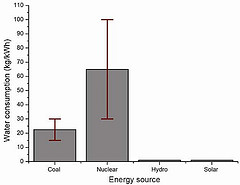 Two professors in India have done the math and found that
there’s plenty of available land in India (much of it on rooftops)
to power its billion people on solar energy alone.
And solar uses less water than nuclear or coal, also as we already knew for the U.S.
Two professors in India have done the math and found that
there’s plenty of available land in India (much of it on rooftops)
to power its billion people on solar energy alone.
And solar uses less water than nuclear or coal, also as we already knew for the U.S.
Today in The Hindu, India can meet energy needs sans N-power: Study,
According to their study, 4.1 per cent of the total uncultivable and
waste land area in India is enough to meet the projected annual demand of 3,400 terawatt-hour (TWh) by 2070 by solar energy alone (1 terawatt-hour per year equals 114 megawatts). The land area required will be further reduced to 3.1 per cent “if we bring the other potential renewable energy sources of India into picture”, they claim. They conclude that land availability is not a limiting constraint for the solar source as believed. According to their study, 4.1 per cent of the total uncultivable and waste land area in India is enough to meet the projected annual demand of 3,400 terawatt-hour (TWh) by 2070 by solar energy alone (1 terawatt-hour per year equals 114 megawatts). The land area required will be further reduced to 3.1 per cent “if we bring the other potential renewable energy sources of India into picture”, they claim. They conclude that land availability is not a limiting constraint for the solar source as believed.
The graph above shows land occupation needed to generate 1 gigawatt hour (1GWh) for each of coal, nuclear, hydroelectric, and solar. It is Figure 3 from the actual study, Is land really a constraint for the utilitzation of solar energy in India? by H. Mitavachan and J. Srinivasan, Current Science, Vol. 103, No. 2, pp. 163-168, 25 July 2012. More from the Hindu article, with graphs from the journal article:
Coal power plants not only transform the land around the facility but also require land for mining coal and its upstream processing, the authors note. An average dam displaces 31,340 persons and submerges 8,748 hectares of land. The direct land footprint of a nuclear power plant includes power plant area, buffer zone, waste disposal area and the land that goes into mining uranium.
“Our study shows that solar power plants require less land in comparison to hydro-power plants and are comparable with coal and nuclear energy power generation when life-cycle transformations are considered,” Mr. Srinivasan said.
While nuclear and fossil fuel-based technologies must continuously transform some land to extract the fuels or dispose of the waste, this is not the case with solar plants. In fact, the same land used for PV solar power plants can be utilised for other purposes like grazing.
The roof-top solar power technology, along with that proposed by IISc professors, “will be able to meet most of the electricity demand, and has the potential to transform the power sector,” says Shankar Sarma, a power policy analyst and author of forthcoming book Integrated Power Policy.
 It’s like the answer to the old Georgia Power misinformation
that it would take clearing land the size of Atlanta to provide
solar power for Atlanta.
We have cleared area like that already: it’s called Atlanta!
And it’s not just land use.
The paper also demonstrates that
solar also uses much less water than coal or nuclear.
We’d already seen
that result for the U.S.
Now Mitavachan and Srinivasan have found the same thing for India:
solar uses little land or water, compared to other power sources,
and there’s enough available land in India to power its entire population
of a billion people.
Less land will be required for solar if it’s
mixed with wind and a bit of hydro, and maybe a tiny amount of natural gas,
as studies have already found for the U.S.
It’s like the answer to the old Georgia Power misinformation
that it would take clearing land the size of Atlanta to provide
solar power for Atlanta.
We have cleared area like that already: it’s called Atlanta!
And it’s not just land use.
The paper also demonstrates that
solar also uses much less water than coal or nuclear.
We’d already seen
that result for the U.S.
Now Mitavachan and Srinivasan have found the same thing for India:
solar uses little land or water, compared to other power sources,
and there’s enough available land in India to power its entire population
of a billion people.
Less land will be required for solar if it’s
mixed with wind and a bit of hydro, and maybe a tiny amount of natural gas,
as studies have already found for the U.S.
-jsq
Short Link: